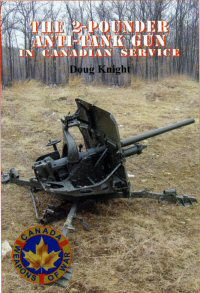 The 2-pounder Anti-Tank Gun in Canadian Service
The 2-pounder Anti-Tank Gun in Canadian Serviceby Doug Knight.
Canada's Weapons of War Series, WOW021
A5 size softback, 24 pages
ISBN: 978-1-894581-36-3
Service Publications,
Canada
www.servicepub.com
Review by Peter Brown
When it was introduced just before the outbreak of WW2 the British 2-pounder was an effective antitank weapon. However events in 1940 meant that it remained in use too long before being replaced, by which time it was no longer adequate on the battlefield. Its usual carriage was a heavy and complex design which gave it great all-round traverse but resulted in a heavy weapon to manhandle. Despite attempts to improve effectiveness with special ammunition and the Littlejohn attachment, they were phased out once sufficient 6-pounder guns became available.
As with most of its weapons at this period, the Canadian army followed British practice and so adopted the 2-pounder as its standard antitank gun.
Originally it was to have equipped infantry units but in the end it was operated mainly by specialised artillery regiments. Guns for Canadian and British use had been ordered at the outbreak of the War, however it was to be well into 1941 before they were available. Canadian units training in the UK initially used British guns and many Canadian ones were used for training at home. Although units in Italy had re-equipped with 6-pounder and 17-pounder guns, a small number were used in late 1944 and their effect makes interesting reading.
This is a good account of an often maligned gun, with details of the changes in guns and carriages described. As well as following the story of Canadian production and service, different attempts at producing self-propelled versions on Carriers and the Lynx Scout Car chassis and the high-velocity "David" guns are also covered.
Photos are well chosen, along with the special and development guns there are several clear photos of standard guns and carriages "in action" including a very useful sequence showing a gun being brought into position after being towed into place. Also helpful for modellers are the 1/35th plans which show the most widely used version both in action and towed configurations and the 6-pounder style carriages and special versions.
With so little in print on the 2-pounder this book will be welcomed as it fills a long-standing gap, giving good background information on Canadian use as well as great photos and plans for anyone wanting to model the gun in service with any British or Commonwealth user.
Thanks to Clive Law at Service Publications for the review book.
